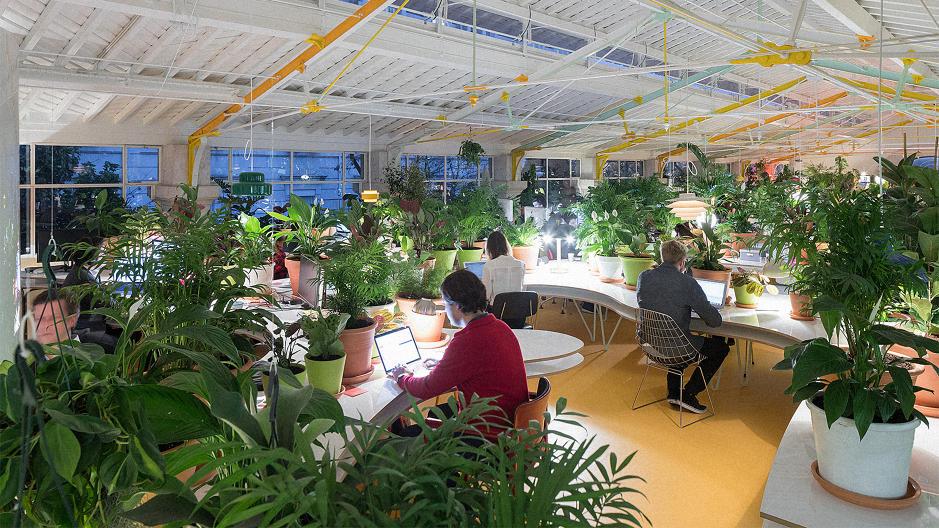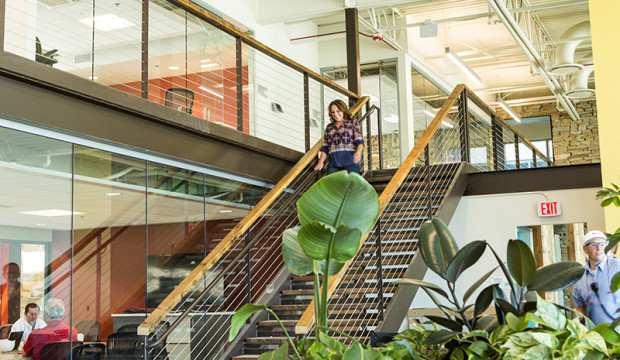
This co-working space in Portugal has 2,000 plants. You don’t need quite that many to have a healthy workspace.
The job market has been opening up. It’s great news for people who want to find a quality job. But it’s not such good news for employers trying to retain their most talented employees.
Employers should pay attention to the findings in this year’s annual “State of the American Workplace” survey from the Gallup Organization. It gives them a game plan for developing the kind working environment talented people are looking for.
A record 47 percent of the workforce say now is a good time to find a quality job. More than half of employees (51 percent) are searching for new jobs or watching for openings. Look around your office – one of every two people wants to leave.
The modern workforce knows what’s important to them and isn’t going to settle. Employees are willing to change jobs until they find a company with a mission and culture that reflects and reinforces their values. They are less willing to settle for a workplace environment that isn’t conducive to their productivity, creativity, and well-being.
Some would even leave their jobs for workspaces that better suit them. In a world still dominated by the open office environment with fewer walls and hardly any private offices, about 40 percent of workers said they would change jobs to get a personal office according to the Gallup survey. Half of all employees say they would switch to a job that allows them flextime, and 37 percent would switch to a job that allows them to work off-site at least part of the time. One-third said they would leave to work somewhere with a thermostat set at a more comfortable temperature.

Employees want natural light and views at work, like here at the new Clif Bar manufacturing plant in Idaho. Photo Courtesy Clif Bar Company
Workers also say they are bothered by noise, by not having a view of the outdoors or natural light, and by constant interruptions.
Employers, your workers are speaking up loud and clear. They are uncomfortable in the workplace. A lot of them want to work somewhere they feel more at home and more productive. A lot of them would literally rather work at home.
You need to listen to what they’re saying to you – without rolling your eyes about those spoiled millennials. They aren’t asking for private offices. They’re not unrealistic about the open office environment. It’s (mostly) here to stay for now.
If there was a way to improve workspaces with these desires in mind, would employees be happier, more productive, and more willing to stay?
There IS a way to improve the workspace and you can do it tomorrow. People are instinctively uncomfortable in sterile offices is their need to find an environment with access to nature.
A 2014 study by the American Psychological Association shows that workers perform better when there are plants around. Dr. Chris Knight says that plants and natural light, and giving people the ability to tune into the normal changes in light as the day progresses makes them happier. Employees are psychologically engaged and better able to perform. When people are locked away from the natural rhythms of the day, they feel disoriented and suffer negative effects on their circadian rhythms.
An international team of three psychologists conducted experiments to see whether a greener office would make workers happier and more productive. It did.
Researchers assigned tasks to two groups of people. One group worked in a plain space. The other group worked with plants. The people in the green office space completed their tasks faster, without any increase in errors. Overall productivity increased 15 percent. Their analysis: a green working environment is consistently more enjoyable for employees, more conducive to concentration, and more productive for the business.
In another experiment, call center employees were assigned to identical workspaces on two different floors of an office building. One floor had plants, and one didn’t. The workers on the “green” floor reported higher work satisfaction, and lower levels of disengagement. They also reported improved air quality.
The researchers hypothesize that plants may have a positive impact on employees due to their own perceptions of their office environment. Because people know that plants can improve air quality, workers may believe they’re breathing cleaner air and working in a healthier environment. A workspace with plants may also give employees the believe their company’s management cares about their well-being.
It might be hard to believe it’s this easy to improve your workplace and increase employee satisfaction. One thing’s for sure: it’s one of the most cost-effective things you can do. Isn’t it worth a try for this reason alone? Can you afford to lose your most productive employees over their discomfort in your work environment?
The Gallup researchers behind the annual Gallup State of the American Workplace report say their goal is to spark conversation and provide leaders with best practices they can apply in their organizations.
Some leaders still need help adjusting to a modern workforce. One thing we know for sure. Employers need to do something, because the millennial generation will soon be the dominant group in the workforce. Baby Boomers are retiring. Millennials will not change their thinking. And consider this: maybe they’ve got it right.
Good Earth Plant Company can help you assess the state of your workplace environment and suggest cost-effective ways to make positive improvements. Get in touch and let’s explore your options.


